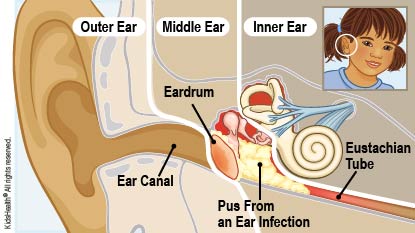Repeated Middle Ear Infections: How to Care for Your Child
Some kids get repeated (also called recurrent) middle ear infections. This can affect their hearing and speech development. Treatments usually can help kids get fewer ear infections.


-
If antibiotics were prescribed, be sure your child takes all the doses exactly as directed, even if he or she is feeling better. This is the best way to kill the harmful bacteria.
-
If your child has pain or is uncomfortable from fever, a medicine may help:
-
If your child has an ongoing medical problem (for example, a kidney, liver, or blood problem): Check with your health care provider before giving medicine for pain or fever.
-
For children younger than 3 months: Check with your health care provider before giving medicine for pain or fever.
-
For children 3–6 months: You may give acetaminophen (such as Tylenol® or a store brand).
-
For children older than 6 months: You may give acetaminophen (such as Tylenol® or a store brand) OR ibuprofen (such as Advil®, Motrin®, or a store brand).
-
Don't give aspirin to your child or teen because it has been linked to a rare but serious illness called Reye syndrome.
-
Encourage your child to drink plenty of fluids.
-
Follow up as recommended by your health care provider.
To reduce the risk of repeated middle ear infections:
-
Don't smoke or allow others to smoke around your child. If anyone in your household smokes, call 1-800-QUIT-NOW (800-784-8669) or visit smokefree.gov for advice and tips on quitting.
-
Breastfeed babies, if possible. If bottle-feeding, hold your baby at an angle (so the head is above the belly) and not horizontally. And don't give your baby a pacifier after 6 months of age.
-
Make sure your child gets all recommended vaccines (shots).
Ear infections aren't contagious (can't be spread to others), but a cold or other virus that can cause an ear infection is contagious. To prevent spreading colds and other viruses:
-
Teach all family members to wash their hands well and often. They should use soap and water and scrub their hands for at least 20 seconds, rinse, and dry thoroughly. If soap and water aren't available, a hand sanitizer with at least 60% alcohol can be used.
-
Help your child avoid other people with colds, if possible.
-
Clean tabletops, doorknobs, and other hard surfaces regularly. Use a cleaner that kills viruses.
-
If your child goes to child care, check to make sure that objects and surfaces are cleaned often, and that tissues, soap and water, paper towels, hand sanitizer, and throwaway wipes are easy to find.

Your child:
-
has new or continued ear pain
-
has fluid or blood coming from the ear
-
isn't drinking
-
vomits more than a few times in 24 hours
-
seems to be getting sicker (for example, can't be comforted or is very sleepy)

Your child:
-
appears dehydrated; signs include dizziness, drowsiness, dry or sticky mouth, sunken eyes, crying with few or no tears, or peeing less often (or having fewer wet diapers)
-
has a swollen or red ear, or pain and redness over the bone behind the ear
-
has neck pain or seems to have a stiff neck

What is a middle ear infection? A middle ear infection — also called otitis media (oh-TYE-tis ME-dee-ah) — is an infection in the space behind the eardrum. When a child has an ear infection, the middle ear fills with pus (infected fluid). This usually happens when germs (viruses or bacteria) from the back of the nose or throat spread into the ear. The middle ear is connected to the back of the throat by a small tube called the eustachian tube. Colds and allergies can make the eustachian tube swell or get blocked. This can lead to a buildup of mucus in the middle ear. Germs that spread from the nose or throat grow in the blocked mucus, causing an infection.
When might health care providers offer treatment to prevent repeated middle ear infections? If a child has three or more middle ear infections in 6 months, or four or more in 1 year, health care providers might suggest a preventive treatment, such as:
-
antibiotic prophylaxis: taking a small dose of oral (by mouth) antibiotics every day, even when the child feels well
-
ear tube surgery: placing tiny plastic tubes in the eardrum. Ear tubes (also called tympanostomy tubes, myringotomy tubes, ventilation tubes, or pressure equalization tubes) can help prevent ear infections by letting fluid drain out. If a child with ear tubes gets an infection, ear antibiotic drops are prescribed. These have fewer side effects than oral antibiotics.
-
other surgery: surgery to remove the adenoids and/or tonsils if they're enlarged and blocking the eustachian tube
Which children with repeated middle ear infections are more likely to need preventive treatment? A health care provider may suggest preventive treatment for kids at higher risk for more frequent and more severe ear infections, such as those who:
-
are younger than 2 years old
-
are around cigarette smoke
-
aren't breastfed
-
still take a pacifier after age 6 months
-
are in child care with lots of other kids
-
have other medical conditions that make it harder for mucus to drain from the middle ear (like Down syndrome or a cleft palate)
-
have problems with their immune system (which protects the body from infections)
-
have hearing loss or speech delay
In older children with no other medical conditions, the health care provider may choose not to offer preventive treatment.